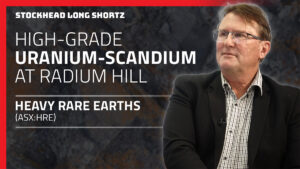Uranium stocks guide: Here’s everything you need to know

Picture: Getty Images
Despite much optimism among the uranium industry, 2019 proved to be more of the same dreary conditions that plagued the sector for the past couple of years.
Uranium prices have been largely stagnant in the past six months, bouncing around in the range between $US23.50 ($34.40) and $US26 per pound.
While that is still a long way down from the record high of $US135 a pound in 2007, it is still a sight better than the low of $US18 per pound it fell to in 2017.
The number of operable reactors worldwide has slipped from 452 in the earlier half of this year to the current 449 reactors, according to the Power Reactor Information System operated by International Atomic Energy Agency.
In this guide, Stockhead explains the factors that have been driving ASX uranium stocks, and what will spur demand — and stock prices — into the future.
What is uranium?
Uranium, which has the chemical symbol U, is a very heavy metal that is primarily used as a fuel to provide nuclear power and is also used in nuclear weapons.
One kilo of uranium can produce about 20 terajoules of energy — as much energy as 1,500 tonnes of coal.
Uranium occurs in most rocks in concentrations of 2 to 4 parts per million and is as common in the Earth’s crust as tin, tungsten and molybdenum, according to the World Nuclear Association.
Australia has the world’s largest uranium resources, accounting for about one-third of the world total.
In terms of production, Australia ranks third behind Kazakhstan and Canada. All of Australia’s uranium is exported because the country does not generate nuclear power.
Demand driving ASX uranium stocks
The outlook for uranium remains uncertain though there is speculation mounting that US President Donald Trump could direct the federal government to buy more uranium from domestic producers – particularly for purchases of uranium by the Defense Department – in response to the US Nuclear Fuel Working Group’s report.
While a previous petition to impose a 25 per cent domestic market quota was rejected earlier this year, a request to use the country’s 1950 Defense Production Act, which will require that the government buy domestic uranium to replenish its stockpiles, could find more traction.
In the long term, demand from China, which has 45 operating reactors, a further 15 under construction and more about to start construction, and Japan, which is continuing its program of reactor restarts, is likely to increase.
Investing in ASX uranium stocks
Peninsula Energy (ASX:PEN) is currently the only company operating in the US that is authorised to use the low pH in-situ recovery method that could improve the operating performance of its Lance Projects in Wyoming. The company is currently focusing on completing a low pH field demonstration.
Berkeley Energia (ASX:BKY) continues to progress its Salamanca uranium mine in Spain towards production. It is expected to produce over 4 million pounds of uranium at a cost of $US13.30 per pound over a 10-year mine life.
Canada-based Laramide Resources (ASX:LAM) is developing uranium projects in New Mexico and Utah in the US, and also has projects in Queensland and the Northern Territory.
Boss Resources (ASX:BOE) recently appointed GE Engineering Services to carry out the definitive feasibility study for the restart of its Honeymoon mine in South Australia. Honeymoon is one of only four Australian mining operations of scale to have a uranium export permit.
Vimy Resources (ASX:VMY) is advancing its “Mulga Rock” project, one of just three companies that have been allowed to go ahead with the development of their uranium mines in Western Australia. The company is currently waiting on secondary permits, licences and approvals and expects to be mine-ready in 2020.
Toro Energy (ASX:TOE) is currently working on an optimisation program to assess the potential to produce a vanadium by-product from the Lake Maitland ore body at its Wiluna uranium mine in Western Australia.
Work on Cauldron Energy’s (ASX:CXU) Yanrey uranium project in Western Australia remains suspended pending improved market sentiment for uranium and government support. The company is currently focused on its Blackwood Goldfield project in Victoria.
Deep Yellow (ASX:DYL) remains on the hunt for uranium in Namibia along with its partner Japan Oil, Gas & Metals National Corporation (JOGMEC) – the minerals exploration arm of the Japanese government.
JOGMEC has to spend $4.5m on exploration within four years of striking the deal to earn a 39.5 per cent stake in the project.
Also focused on Namibia, Bannerman Resources (ASX:BMN) has a 95 per cent stake in the Etango uranium project, which is expected to produce 7-9 million pounds of uranium each year for the first five years and 6-8 million pounds each year after that, for an initial 16 years.
Marenica Energy (ASX:MEY) rounds off the Namibian uranium explorers. The company recently identified an extensive 3.6km by 1.2km palaeochannel at its Koppies tenement through drill holes intersecting the target calcrete hosted mineralisation. Assay results are expected in January 2020.
Related Topics

UNLOCK INSIGHTS
Discover the untold stories of emerging ASX stocks.
Daily news and expert analysis, it's free to subscribe.
By proceeding, you confirm you understand that we handle personal information in accordance with our Privacy Policy.








